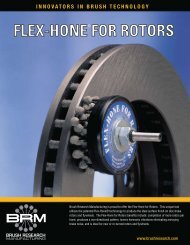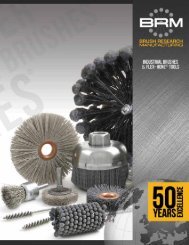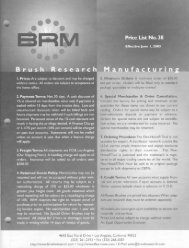Common Practices In CYLINDER BORING, HONING, AND WALL ...
Common Practices In CYLINDER BORING, HONING, AND WALL ...
Common Practices In CYLINDER BORING, HONING, AND WALL ...
You also want an ePaper? Increase the reach of your titles
YUMPU automatically turns print PDFs into web optimized ePapers that Google loves.
will not listen to any argument. If a young man reads in a magazine that<br />
one of his well known racing engine idols uses a fine finish, then that is<br />
what his car must have. It is just not so. Or not NECESSARILY so.<br />
Where do I get my qualifications I don’t have any, really. But I have<br />
spent many hundreds of hours at Trade Shows in most countries of the<br />
world, talking, discussing, and arguing with engineers from every walk of<br />
life. I have spent hundreds of hours in Engineering and Service Departments<br />
of many, many engine manufacturers, talking, explaining, and asking<br />
questions. And I have read every book and engineering paper I could get<br />
my hands on written on the subject.<br />
My biggest answer to most generalized questions is “It just depends - it has<br />
to be qualified to the situation. There is no stock answer.” There isn’t any<br />
one person who has all the answers. This includes all the guys that think<br />
they are experts.<br />
If you have read this far, I thank you for listening to my personal opinions.<br />
Keep an open mind. Experiment. Do not be afraid to try something new.<br />
TO ALL THE OTHER ENGINEERS OF THE INDUSTRY<br />
… Whose only connection with the combustion engine is to drive it back<br />
and forth to work: THERE ARE MANY <strong>CYLINDER</strong>S in automated machines,<br />
pneumatics, hydraulics, that need deburring at the cross hole entrances that<br />
need finishes to prevent weepage. There are air compressors, shotguns,<br />
and air cylinders. There are problems of providing the necessary clearance<br />
for valve guide stems, connecting rod pins and bolt holes, bronze shoe pins,<br />
cleaning cam follower holes, intake valves of all types and sub-surface oil<br />
pumps, tapered tubings that need tapered hones, step-down cylinders that<br />
need certain finishes.<br />
CHIT-CHAT<br />
Among other things, my Dad was a farmer, and I well remember when farm<br />
tractors started to make their appearance. Forward looking farmers, and<br />
particularly the young ones, could not wait to get their hands on a Fordson.<br />
There were many skeptics. The farm tractor did not look like a team of<br />
horses, it cost more, and they were sure that the machine was so heavy that<br />
it would pack down their land so hard that nothing would grow on it. The<br />
salesmen put on a big community demonstration and had answers for the<br />
economy and the performance, but the last excuse they could not counter.<br />
It took many years. The progressive ones had no time to worry about<br />
face-saving or that the days of the hay burners, lodged in their barns, were<br />
numbered or to admit that they really could not afford a tractor. They got<br />
one and plowed new furrows, more of them, deeper and straighter than ever<br />
before.<br />
We still have the progressives and the skeptics today. But with the second<br />
group it just takes a little longer.<br />
At many, many shows sponsored with the conventions of the Society of<br />
Automotive Engineers, Society of Mechanical Engineers, Design Shows,<br />
Society of Petroleum Engineers, Automotive Service <strong>In</strong>dustries, etc., we<br />
always had the busiest booth at the show. We had something new and<br />
we demonstrated. Most times there were from 5 to 20 engineers in front<br />
of the booth. And barring interruptions, and if they listened that long, this<br />
Booklet is my entire sales pitch. At least a couple of times a day when I<br />
had gone through my routine and had finished answering questions as best I<br />
could, some guy would pipe up from the edge of the group and say, “What<br />
the man says is true. I know. We use them.” Such comments were the<br />
rewards of the day.<br />
Try a Flex-Hone. The principles of finish are not that much different from the<br />
sealing process of a piston ring with a cylinder wall. The same basic ideas<br />
still apply. We will work with you, and make samples for experimentation.<br />
The sample goes with a memo billing. If it does not work out, return it. If it<br />
does work out, and you keep it, all we need is a P.O. to cover it.<br />
We say we don’t guarantee our product because we do not know when<br />
someone will try to use a pocket knife to cut a nail in two, or use a cold<br />
chisel to pare an apple. But we do strive to guarantee a satisfied customer.<br />
Although you can get fast service from our factory on any of your needs, be<br />
sure you have our Catalog and check our website at<br />
www.brushresearch.com for more information on the Flex-Hone as well as<br />
other available on-line literature. <strong>In</strong> Europe, Scandinavia, the UK, Middle<br />
East, North Africa, South Africa, The Far East, Japan, and Oceania, Australia<br />
and New Zealand, we have distributors who carry stock and have competent<br />
advisors. We also have distributors in most countries in South America.<br />
Steve A. Rands Founder of:<br />
Brush Research Manufacturing<br />
11





